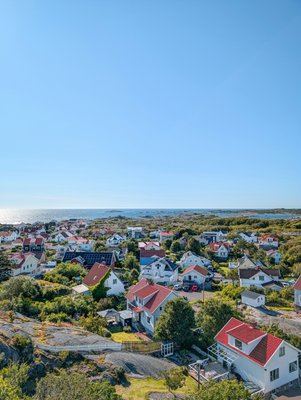A small fishing community in Sweden's west coast archipelago, with red wooden houses, granite cliffs, and a small harbor where local boats dock year-round.
Fotö sits in the middle of Gothenburg’s archipelago, linked by bridge to Hönö and surrounded by waters known for their clarity. In summer, people come for wooden diving towers, cafes with views of sailboats, and small coves near Tån in the northwest. You’ll find traces of a 17th-century port and stone markers from earlier centuries, reminders of the island’s maritime history. Walk across rocky shorelines, follow trails edged by pine trees, or take a short trip to nearby islands via the bridge.
Swimming Areas with Wooden Platforms and Coastal Access
Jump from wooden platforms or climb towers at Fotö’s swimming spots, where clear water and rocky coves create good conditions for swimming. Families gather at the main beaches, where shallow sections and low bridges suit younger visitors. For quieter spots, take paths leading to Tån in the northwest, where isolated rocks and small bays let you swim without many people nearby. The water here is deep enough for diving from higher platforms, and smooth rocks underwater attract those with snorkels on still days. Wear shoes with grip for walking over uneven coastal rocks, and arrive before midday in summer to find space on sunlit surfaces.
Waterfront Cafe with Harbor Views
Pause at Fotö’s cafe for coffee or sandwiches at outdoor tables facing the harbor. Watch ferries and small fishing boats move past as you eat, or look for sailboats in the distance during late afternoons. The menu includes cinnamon pastries, salads with smoked salmon, and bread made with ingredients from local suppliers. On days with strong winds, the indoor area fills with the aroma of baking and conversations about the day’s weather. The cafe shuts before dark, so plan to visit during daylight hours after swimming or walking.
Remains of a 17th-Century Port and Viking-Era Markers
The old port area, once the island’s main hub, now has stone foundations and iron rings once used to secure ships. Follow trails marked with signs to see rune stones and burial grounds tucked between pine trees, some from the Viking Age. Plaques in Swedish and English detail Fotö’s history as a trading and fishing center. Near the eastern shore, a moss-covered cellar from a merchant’s house built in the 1600s lies half-buried in the ground. These sites are free to explore on your own—grab a map from the ferry terminal to locate them.
Walking or Biking to Hönö via the Bridge
A short bridge connects Fotö to Hönö, letting you travel between the two islands by foot, bike, or car. The 10-minute walk across gives views of tide pools and seabirds, with benches along the way for breaks. On Hönö, you’ll find more restaurants serving seafood, a compact museum about local seafaring history, and buses to Gothenburg. Cyclists can ride a loop around both islands in under two hours, passing fishing sheds and patches of wild berries. Plan your trip during low tide to spot people gathering mussels and crabs from rocks exposed by the receding water.
Getting to Fotö by Ferry or Road
Ferries leave from Gothenburg’s Saltholmen terminal to nearby islands, with a bus or bike ride needed to reach Fotö’s bridge. If driving, cross from Hönö via the bridge and park in gravel lots near the main swimming spots. Ferries run more often on summer weekends, but weekdays are less busy. Check schedules ahead of time, as service slows after September. If traveling without a car, allow about 90 minutes to reach Fotö from central Gothenburg.

















